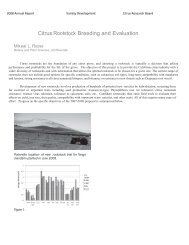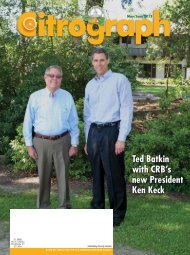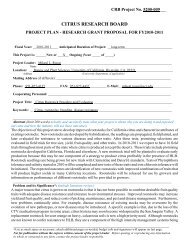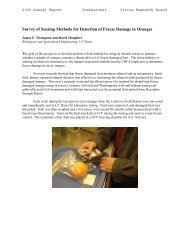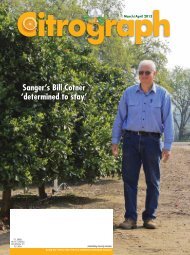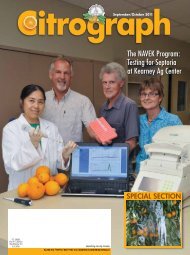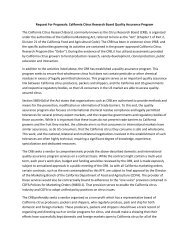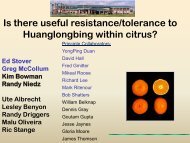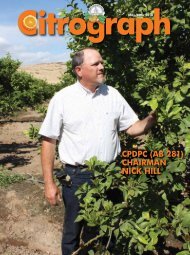Beth Grafton-Cardwell and her team at Lindcove - Citrus Research ...
Beth Grafton-Cardwell and her team at Lindcove - Citrus Research ...
Beth Grafton-Cardwell and her team at Lindcove - Citrus Research ...
Create successful ePaper yourself
Turn your PDF publications into a flip-book with our unique Google optimized e-Paper software.
PERIOD OF NATURALISM<br />
<strong>and</strong> many shipments sent east on specul<strong>at</strong>ion were<br />
left rotting on Midwestern <strong>and</strong> eastern rail docks.<br />
The need for marketing organiz<strong>at</strong>ions <strong>and</strong> a<br />
cooper<strong>at</strong>ive marketing str<strong>at</strong>egy was apparent <strong>and</strong><br />
was soon met by newly organized groups like the<br />
California Fruit Growers Exchange (now Sunkist)<br />
<strong>and</strong> the Mutual Orange Distributors.<br />
ADVERTISING PERIOD<br />
Argonaut, circa 1910 -1915<br />
Mountain Lion, circa 1900 -1905<br />
La Mesa, circa 1890 -1899<br />
Upl<strong>and</strong> Quail, circa 1905 -1915<br />
Camp Fire, circa 1905 -1910<br />
22 Citrograph July/August 2011<br />
The first labeling<br />
As early as the mid-1880s, proud growers<br />
saw the need to distinguish their fruit from ot<strong>her</strong><br />
growers’ product. The first labeling was crude<br />
<strong>and</strong> inform<strong>at</strong>ional, consisting of h<strong>and</strong>-painted or<br />
stenciled box heads with grower <strong>and</strong> geographic<br />
inform<strong>at</strong>ion only.<br />
With this increase in marketing effort, eastern<br />
produce buyers began to recognize w<strong>her</strong>e the<br />
quality fruit was being grown. Areas like Riverside,<br />
Redl<strong>and</strong>s, Ontario <strong>and</strong> Pomona became<br />
known for their quality fruit. As the influence<br />
of marketing organiz<strong>at</strong>ions increased, so did the<br />
need for advertising <strong>and</strong> influential labeling.<br />
It is believed th<strong>at</strong> the first true labels were used<br />
in 1887. Some were done as single color wood<br />
block prints <strong>and</strong> ot<strong>her</strong>s as multicolor stone lithographs.<br />
Some early packers in the Riverside area<br />
used small round labels depicting br<strong>and</strong> <strong>and</strong> grade<br />
of fruit, centered on a partially stenciled box end<br />
with exchange inform<strong>at</strong>ion. Simultaneously, some<br />
packers were using full-size square labels th<strong>at</strong><br />
covered the box end <strong>and</strong> printed all inform<strong>at</strong>ion<br />
in full color. Round labels were approxim<strong>at</strong>ely 6”<br />
in diameter, <strong>and</strong> square labels were approx. 9” x<br />
10” in size. The larger size square labels were soon<br />
the st<strong>and</strong>ard of the industry as more inform<strong>at</strong>ion<br />
could be offered in a larger, bold, artistic form<strong>at</strong>.<br />
Several west <strong>and</strong> east coast lithographic printers<br />
began to specialize in fruit box labels of all<br />
types <strong>and</strong> designs. Many prominent artists of the<br />
time were employed by the lithograp<strong>her</strong>s to design<br />
images <strong>and</strong> lettering. One such artist was Herman<br />
Hansen, who was employed by the H.S. Crocker<br />
Litho Co. of San Francisco. Many of the early<br />
western design labels were designed by Hansen.<br />
<strong>Citrus</strong> industry researc<strong>her</strong> <strong>and</strong> art historian<br />
Gordon Mc Clell<strong>and</strong> has divided the label era into<br />
three distinct periods: N<strong>at</strong>uralism, Advertising<br />
<strong>and</strong> Commercial Art. 1<br />
N<strong>at</strong>uralism (1887 – 1920): This period played<br />
on the mystique of the western frontier. Little effort<br />
was made to represent the fruit itself. Labels<br />
of this period depicted images of western geography,<br />
N<strong>at</strong>ive Americans, pioneer <strong>her</strong>oes, Mexican<br />
<strong>her</strong>itage, beautiful women, birds <strong>and</strong> animals.<br />
These wonderful images of western life not<br />
only sold the fruit, but sold the virtues of the<br />
west itself. It’s been said th<strong>at</strong> many an easterner<br />
made their final decision to go west while e<strong>at</strong>ing<br />
a delicious California orange <strong>and</strong> viewing the<br />
compelling image depicted on the label. One can<br />
certainly underst<strong>and</strong> how on a bitterly cold winter<br />
Tesoro, circa 1930 -1935<br />
Flavorite, circa 1925 -1930<br />
Progressive, circa 1925<br />
Corona Cooler Lemon, circa 1930<br />
Cal Oro, circa 1930




